高级计算机图形学ACG00
- 格式:pdf
- 大小:5.61 MB
- 文档页数:94
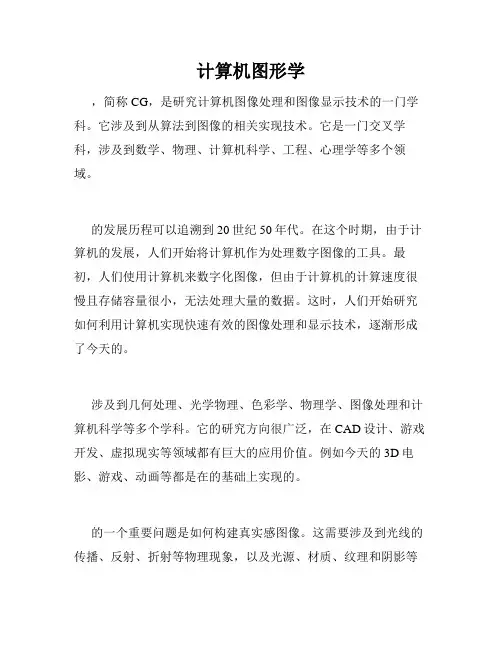
计算机图形学
,简称CG,是研究计算机图像处理和图像显示技术的一门学科。
它涉及到从算法到图像的相关实现技术。
它是一门交叉学科,涉及到数学、物理、计算机科学、工程、心理学等多个领域。
的发展历程可以追溯到20世纪50年代。
在这个时期,由于计算机的发展,人们开始将计算机作为处理数字图像的工具。
最初,人们使用计算机来数字化图像,但由于计算机的计算速度很慢且存储容量很小,无法处理大量的数据。
这时,人们开始研究如何利用计算机实现快速有效的图像处理和显示技术,逐渐形成了今天的。
涉及到几何处理、光学物理、色彩学、物理学、图像处理和计算机科学等多个学科。
它的研究方向很广泛,在CAD设计、游戏开发、虚拟现实等领域都有巨大的应用价值。
例如今天的3D电影、游戏、动画等都是在的基础上实现的。
的一个重要问题是如何构建真实感图像。
这需要涉及到光线的传播、反射、折射等物理现象,以及光源、材质、纹理和阴影等
概念。
为了实现真实感图像,人们发展了许多算法和技术,包括光线跟踪、光线追踪、全局光照等技术。
此外,还涉及到模型构建、动画生成等研究。
例如在CAD设计中,人们使用模型构建技术来创建各种复杂的机械部件、汽车、建筑等模型。
在动画生成中,人们使用动画序列技术来模拟各种动态的过程,例如游泳、跑步、跳舞等。
总之,是一个极具挑战性和创新性的领域,它的研究成果已经广泛应用到游戏、影视、工程、航天、医学等领域。
随着计算机性能的不断提升和算法技术的不断更新,必将迎来更加广阔的发展空间。

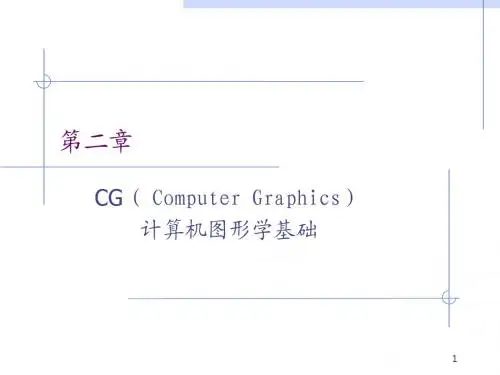

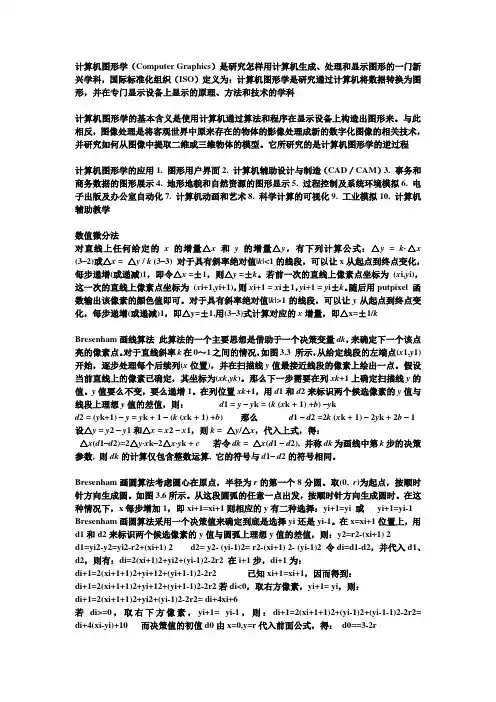
计算机图形学(Computer Graphics)是研究怎样用计算机生成、处理和显示图形的一门新兴学科,国际标准化组织(ISO)定义为:计算机图形学是研究通过计算机将数据转换为图形,并在专门显示设备上显示的原理、方法和技术的学科计算机图形学的基本含义是使用计算机通过算法和程序在显示设备上构造出图形来。
与此相反,图像处理是将客观世界中原来存在的物体的影像处理成新的数字化图像的相关技术,并研究如何从图像中提取二维或三维物体的模型。
它所研究的是计算机图形学的逆过程计算机图形学的应用1. 图形用户界面2. 计算机辅助设计与制造(CAD/CAM)3. 事务和商务数据的图形展示4. 地形地貌和自然资源的图形显示5. 过程控制及系统环境模拟6. 电子出版及办公室自动化7. 计算机动画和艺术8. 科学计算的可视化9. 工业模拟10. 计算机辅助教学数值微分法对直线上任何给定的x的增量△x和y的增量△y,有下列计算公式:△y =k·△x (3–2)或△x = △y / k (3–3) 对于具有斜率绝对值|k|<1的线段,可以让x从起点到终点变化,每步递增(或递减)1,即令△x =±1,则△y =±k。
若前一次的直线上像素点坐标为(x i,y i),这一次的直线上像素点坐标为(x i+1,y i+1),则x i+1 = x i±1,y i+1 = y i±k。
随后用putpixel 函数输出该像素的颜色值即可。
对于具有斜率绝对值|k|>1的线段,可以让y从起点到终点变化,每步递增(或递减)1,即△y=±1,用(3–3)式计算对应的x增量,即△x=±1/kBresenham画线算法此算法的一个主要思想是借助于一个决策变量dk,来确定下一个该点亮的像素点。
对于直线斜率k在0~1之间的情况,如图3.3 所示,从给定线段的左端点(x1,y1)开始,逐步处理每个后续列(x位置),并在扫描线y值最接近线段的像素上绘出一点。

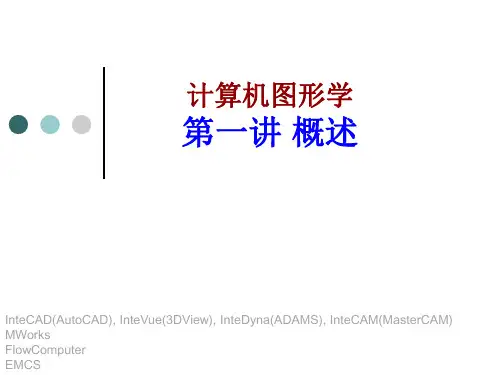
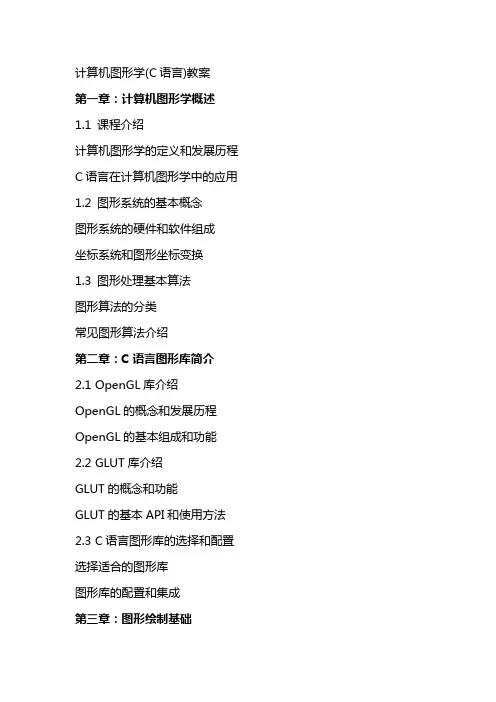
计算机图形学(C语言)教案第一章:计算机图形学概述1.1 课程介绍计算机图形学的定义和发展历程C语言在计算机图形学中的应用1.2 图形系统的基本概念图形系统的硬件和软件组成坐标系统和图形坐标变换1.3 图形处理基本算法图形算法的分类常见图形算法介绍第二章:C语言图形库简介2.1 OpenGL库介绍OpenGL的概念和发展历程OpenGL的基本组成和功能2.2 GLUT库介绍GLUT的概念和功能GLUT的基本API和使用方法2.3 C语言图形库的选择和配置选择适合的图形库图形库的配置和集成第三章:图形绘制基础3.1 图形绘制基本概念图形绘制原理图形绘制流程3.2 基本图形的绘制点、线、圆的绘制方法字符和图像的显示3.3 颜色和光照处理颜色模型和颜色转换光照模型和光照计算第四章:图形变换和模型视图4.1 图形变换坐标变换和矩阵运算几何变换和图像变换4.2 模型视图视图变换和投影相机控制和视角设置4.3 三维图形绘制三维图形的建模和绘制方法曲面和体的绘制技巧第五章:动画和交互技术5.1 动画基础动画的概念和分类动画的实现方法和算法5.2 关键帧动画关键帧动画的原理和实现动画插值和优化技术5.3 交互技术用户输入和事件处理鼠标和键盘交互设计第六章:图形算法6.1 填充算法扫描线填充算法原理种子填充算法原理6.2 裁剪算法裁剪的概念和分类凸多边形裁剪算法6.3 图像分割算法图像分割的概念和应用阈值分割算法和区域生长算法第七章:图像处理基础7.1 图像处理基本概念数字图像的表示和存储图像处理的基本操作7.2 图像增强图像增强的目的和方法直方图均衡化和对比度增强7.3 图像滤波滤波器的设计和分类线性滤波和非线性滤波第八章:OpenGL高级功能8.1 纹理映射纹理映射的概念和原理纹理坐标和纹理映射过程8.2 光照模型光照模型的概念和分类Phong光照模型和Blinn-Phong光照模型8.3 阴影技术阴影的类型和方法软阴影和硬阴影的实现第九章:图形编程实践9.1 绘制一个简单的三角形设置窗口和初始化OpenGL绘制一个三角形的基本步骤9.2 实现一个简单的动画动画的原理和实现方法绘制一个旋转的立方体动画9.3 开发一个简单的图形应用程序图形应用程序的开发流程设计一个简单的3D场景第十章:项目实践10.1 项目选择和规划选择适合的项目主题制定项目开发计划10.2 项目开发和实现按计划进行项目开发解决项目开发过程中遇到的问题10.3 项目测试和优化测试项目的功能和性能对项目进行优化和改进第十一章:图形硬件和性能优化11.1 图形处理器(GPU)GPU的工作原理和架构GPU编程模型和API11.2 图形性能优化渲染管线和性能瓶颈优化技巧和策略11.3 实时图形渲染实时图形渲染的挑战实时渲染技术和算法第十二章:计算机动画12.1 动画原理和技术关键帧动画和补间动画骨骼动画和蒙皮动画12.2 动画编辑和播放动画编辑器的实现动画播放器和交互控制12.3 物理动画和效果粒子系统和不规则动画流体动力学和模拟动画第十三章:虚拟现实和增强现实13.1 虚拟现实技术VR系统的原理和设备VR应用程序开发和实践13.2 增强现实技术AR系统的原理和设备AR应用程序开发和实践13.3 混合现实和交互混合现实的概念和应用虚拟物体与现实世界的交互第十四章:图形学综合案例分析14.1 图形学应用案例游戏开发和图形学的关系图形学在其他领域的应用案例14.2 图形学项目的挑战和解决方案项目开发过程中的常见问题解决方案和最佳实践14.3 图形学未来趋势和展望图形学的发展方向图形学在未来的应用前景第十五章:课程总结和考试15.1 课程回顾本门课程的主要内容和知识点学生的学习成果和收获15.2 考试内容和策略考试的形式和要求考试的准备和复习策略15.3 课程反馈和改进学生对课程的评价和建议课程的改进方向和计划重点和难点解析第一章:重点:计算机图形学的定义和发展历程,C语言在计算机图形学中的应用。

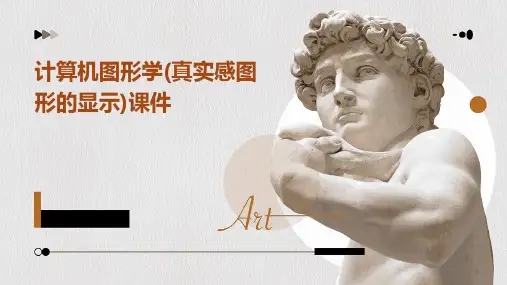
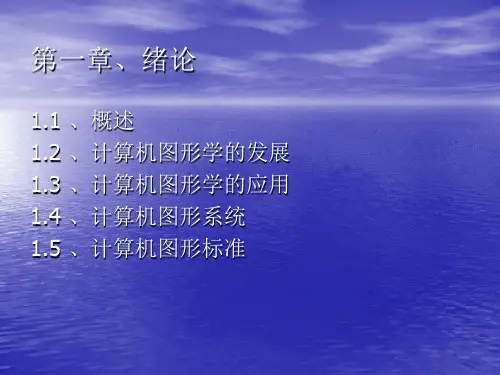
高级计算机图形学Advanced Computer GraphicsCourse No. 04814560主讲教师:裴玉茹Instructor: Yuru PeiEmail: peiyuru@Department of Machine IntelligencePeking UniversityWelcome to Advanced Computer Graphics Introductions–Instructor: 裴玉茹•Office: Science Building 2, 2224#•Email: peiyuru@.cm•Office Phone: 62756657–TA:魏嘉•Email: weijia@About this courseTopicsAbout This CourseAdvanced Computer Graphics–Course NO. 04814560Webpage–/vision/Visual&Robot/people/pei%20yuru/acg09.htm 14 Lectures + 2 PresentationsTime and Place–Monday, 14:40-17:40–Teaching Building 2, 413About This Course Evaluation Method–Final Score = 80%A+20%B–A: Two class projects and written assignments•Presentation•Programming•Reading report–B :Final examination–Bonus☺PrerequisitesIntroduction to Computer Graphics–Familiar with concepts in ComputerGraphicsProgramming background in C/C++–OpenGL / Directx3DMathematics–Linear algebraReferencesAkenine-Moller and Haines, Real-time rendering (2/3 ed), AK PETERS, LTD.Alan Watt. 3D Computer Graphics, (3rd ed), Addison-Wesley, 1999.Kerlow, Isaac Victor, The art of 3D computer animation and effects(3rd ed),John Wiley, 2004.Donald Hearn,M.Pauline Baker,Computer Graphics with OpenGL,(3rd ed),Pearson,2004.James D. Foley, Andries van Dam, Steven K. Feiner, John F. Hughes, Computer Graphics: Principles and Practice in C, (2nd ed),Addison-Wesley Professional, 1995.Dave Shreiner, Mason Woo, Jackie Neider, Tom Davis,OpenGL Programming Guide: The Official Guide to Learning OpenGL®, Addison Wesley Professional.Course Goals Introduce current trends of computergraphics-Conference, JournalsThe state of art of computer graphics–Digital cartoon movies –Computer games3D DigitalCartoon Movie3D ComputerGameCGResearchCGConferenceCG JournalCGResearcherTrends of Computer Graphics Conference–ACM SIGGRAPH•International Conference on Computer Graphics andInteractive Techniques•30,000~40,000 participants, 20%, ToG–EuroGraphics•Annual Conference of the European Association forComputer Graphics•500~600, 20%, Computer Graphics Forum–PG•Pacific Conference on Computer Graphics and Applications •Approx. 400, the Visual Computer/ Computer GraphicsForumTrends of Computer GraphicsJournal–ACM ToG•Transactions on Graphics–IEEE Trans. VCG•Transactions on Visualization and Computer Graphics –IEEE Computer Graphics & Application–The Visual Computer–Computer Graphics Forum–Computer Animation and Virtual WorldsTrends of Computer Graphics ResearchersThe ACM SIGGRAPH Awards program–The Steven A. Coons Award–The Computer Graphics Achievement Award–The Significant New Researcher AwardLaboratory–Computer Graphics Group at Stanford University–Computer Graphics Lab at MIT–Computer Graphics Lab at ETH Zurich–MSRA–State Key Lab of CAD&CG at ZJU–...2008 Computer Graphics AchievementAward to Ken PerlinTwo-dimensional slice through 3D PerlinnoisePerlin noise rescaled and added into itself tocreate fractional Brownian motion.2007 Computer Graphics AchievementAward to Greg WardHigh Dynamic Range ImagingAcquisition, Display, Image-BasedLighting–a set of techniques that allows agreater dynamic range of exposures-the range of values between light andark areasThe intention of HDRIto accurately represent the wide range ofintensity levels found in real scenes ranging from directsunlight to shadows.2004 Computer Graphics Achievement Award to Hugues Hoppe Pioneering work on–Surface reconstruction–Progressive meshes–Geometry texturing and geometry images.PhD thesis “Surface reconstruction from unorganized points,”advised by TonyDeRoseHugues Hoppe, Tony DeRose, etc., PiecewiseSmooth Surface Reconstruction, in Siggraph942003 Computer Graphics Achievement Award to Peter Schröder Contributions to the newly emergingarea of 3D geometry processing–Form the basis of the research incomputer graphics and digitalgeometry processing–Subdivision surfaces–Multiresolution modelingD. Zorin, P. Schröder, W. Sweldens:Interactive multiresolution meshediting. In SIGGRAPH 97Like Teacher, Like Student2002 SIGGRAPH computer graphics achievement award to David B. Kirk Key technical role in bringing highperformance computer graphics systems tothe mass market–Offered z-buffering and shading infirmware–The Apollo DN1000VS, the firstworkstation to offer hardware texturemapping–Researching algorithms for ray tracingacceleration, object oriented raytracing, and global illuminationHe joined NVIDIA in 1996. There he drove development of the RIVA128, the RIVA TNT,the GeForce, the GeForce2, GeForce3, and GeForce42001 Computer Graphics Achievement Award to Andrew Witkin Pioneering work in bringing a physics basedapproach to computer graphicsWork on active contours (snakes)anddeformable models, variational modeling,scale-space filtering, space timeconstraints, and dynamic simulationPhD. at MIT in the Psychology department onthe perception of surface orientation fromtexture statisticsTechnique of Scale-Space Filtering–A classic in the multi-resolution signalanalysis literatureStuart Little Monsters Inc.First of this century's Computer Graphics Achievement Award to David Salesin Pioneering the field of non-photorealisticrendering and introducing it to theSIGGRAPH communityHis work on computer generated pen andink illustrations and subsequentlycomputer-generated watercolors areconsidered landmarks in this emergingfield.He then spent the year with photorealisticrendering at the Program of ComputerGraphics at Cornell University.He has worked at the Lucasfilm, Pixar.1999 Computer Graphics Achievement Award -Anthony D. DeRose Seminal work in making subdivisionsurfaces a practical geometricmodeling technique–Only two widely accepted geometricprimitives in computer graphics•Polygons and parametric patches–DeRose's work will surely add anotherprimitive to the geometric modeler'spantheon -subdivision surfaces.T. DeRose, M. Kass, T. Truong,Subdivision Surfaces in CharacterAnimation, in SIGGRAPH 98Course GoalsIntroduce current trends of computer graphics -Conference, Journals, Researchers The state of art of computer graphics –Digital cartoon movies–Computer games 3D DigitalCartoon Movie3D ComputerGame CG Research CG Conference CG Journal CGResearcherState of art of computer graphics Digital Cartoon MoviesPIXAR–1995 Toy Story–1998 A Bug's Life–1999 Toy Story 2–2001 Monsters, Inc.–2003 Finding Nemo–2005 The IncredibleDeamworks–2001Shrek–2004 Shrek 2–Shrek 3Have fun!☺Cartoon Movie3D ComputerGameState of art of computer graphics Digital Cartoon MoviesPIXAR–1995 Toy Story–1998 A Bug's Life–1999 Toy Story 2–2001 Monsters, Inc.–2003 Finding Nemo–2005 The IncrediblesDeamworks–2001Shrek–2004 Shrek 2–Shrek 3…Have fun!☺Cartoon Movie 3D ComputerGame长江七号Final FantasyOutlineThe graphics rendering pipelineTransformsVisual appearanceTexturingAdvanced lighting and shadingNon-photorealistic renderingImage-based renderingAcceleration algorithmsPipeline optimizationPolygonal techniquesCurves and curved surfaceIntersection test methodsCollision detectionReadings3D Mesh ProcessingParameterization3D Mesh Feature Description and Shape AnalysisTexture Mapping and Non-Photorealistic Rendering3D Animation3D Mesh ProcessingMesh Processing–Surface reconstruction from unorganized points [Hoppe94 ]–Progressive mesh [Hoppe96 ]–Terrain rendering [Hoppe04]P. Sander, J. Snyder, S. Gortler, H. Hoppe.Texturemapping progressive meshes. ACM SIGGRAPH 2001,409-416.H. Hoppe. Progressive meshes. ACM SIGGRAPH 1996,99-108.Hugues Hoppe, Tony DeRose, etc., Piecewise SmoothSurface Reconstruction, in Siggraph94F. Losasso, H. Hoppe. Geometry clipmaps: Terrainrendering using nested regular grids. SIGGRAPH 2004, 769-776.References3D Mesh ProcessingSubdivision surfaces–Subdivision surfaces used in CharacterAnimation [Derose98]Visualization of very large surface models–Streaming Meshes [Isenburg 05]–Out-of-core construction and accurate view-dependent visualization [Cignoni04]Super-Resolution of 3D Face [Pan06]Geri’s Game [Pixar]T. DeRose, M. Kass, and T. Truong. Subdivision Surfaces in Character Animation. In Proc. ACM SIGGRAPH 1998,Computer Graphics Proceedings, Annual Conference Series, pages 85-94. ACM Press / ACM SIGGRAPH, July 1998.M. Isenburg, P. Lindstrom, Streaming Meshes, Proceedingsof Visualization'05, pp. 231-238, October 2005.G. Pan, S. Han, Z. Wu, and Y. Wang , Super-Resolution of3D Face, ECCV06, 389-401, LNCS3952P. Cignoni, F. Ganovelli, E. Gobbetti, F. Marton, F. Ponchio,and R. Scopigno. Adaptive TetraPuzzles-Efficient Out-of-core Construction and Visualization of Gigantic PolygonalModels. ACM Transactions on Graphics, 23(3), pp. 796-803, Proc. SIGGRAPH 2004ReferencesParameterizationMRA (Multi-ResolutionAnalysis)–Multiresolution Analysis ofArbitrary Meshes[Eck95]MAPS: MultiresolutionAdaptive Parameterization of Surfaces [Lee98]Multiresolution Mesh Editing[zorin97]M. Eck, T. DeRose, T. Duchamp, H. Hoppe, M. Lounsbery,W. Stuetzle. Multiresolution analysis of arbitrary meshes.SIGGRAPH 1995, 173-182, 1995.A. Lee, W. Sweldens, P. Schrder, L. Cowsar and D. Dobkin.MAPS: Multiresolution Adaptive Parameterization ofSurfaces. Proceedings of SIGGRAPH 98. pp. 95-104, July1998D. Zorin, P. Schroder, and W. Sweldens. InteractiveMultiresolution Mesh Editing. In Proc. ACM SIGGRAPH1997, Computer Graphics Proceedings, pp. 259-268. 1997 ReferencesParameterization Normal Mesh [Guskov2000]Consistent MeshParameterizations[Praun2001] Displaced Subdivision Surfaces[Lee2000]I. Guskov, K. Vidimce, W. Sweldens, P. Schröder, Normal Meshes, Computer Graphics Proceedings (SIGGRAPH 2000), pp 95-102, 2000E. Praun, W. Sweldens and P. Schrder. Consistent Mesh Parameterizations. Proceedings of ACM SIGGRAPH 2001. pp. 179-184, 2001.A. Lee, H. Moreton, and H. Hoppe. Displacedsubdivision surfaces. In Proc. ACM SIGGRAPH 2000, 2000.ReferencesParameterizationCorrespondence establishment and applications Optical flow based methods–Creating Face Models [Blanz99]Reconstruction and parameterization from range scans[Allen 02]Deformation Transferring [Sumner 04]V. Blanz and T. Vetter. A Morphable Model for theSynthesis of 3D Faces. In Proc. ACM SIGGRAPH 1999, pp.187-194. ACM Press / ACM SIGGRAPH, 1999.B. ALLEN, B. CURLESS, and Z. POPOVI. The space of all body shapes: reconstruction and parameterization from range scans. ACM Transactions on Graphics (ACM SIGGRAPH 2003), 22, 3, pp. 587-594.R. W. Sumner, J. Popovic, Deformation Transfer for Triangle Meshes, in SIGGRAPH 2004, pp. 399 –405.References3D Mesh Feature Description and ShapeAnalysisShape Matching for Model Alignment[ICCV05 short course]–From global to local–Translation and rotation invariant---#-min-=PCA Alignment3D Mesh Feature Description and ShapeAnalysisAlignment and Matching [SIG04 course]Reflective Symmetry Detection in ThreeDimensions [Podolak06]Matching 3D Models with ShapeDistributions [Osada01]Robust 3D Face Matching [Lu06]J. Podolak, P. Shilane, A. Golovinskiy, S. Rusinkiewicz,and T. Funkhouser. A planar-reflective symmetrytransform for 3D shapes. ACM Transactions on Graphics (Proc. SIGGRAPH), 25(3), July 2006.X. Lu , A. K. Jain, and D. Colbry, Matching 2.5D FaceScans to 3D Models, IEEE Transactions on PatternAnalysis and Machine Intelligence, vol. 28, no. 1, pp. 31-43, Jan. 2006.R. Osada, T. Funkhouser, B. Chazelle, D. Dobkin.Matching 3D Models with Shape Distributions. Proc. ofthe International Conference on Shape Modeling &Applications, pp. 154, 2001ReferencesTexture Mapping and Non-PhotorealisticRenderingIntroduction to Texture MappingExpression mapping with ratio image [Liu01]Realistic shading of human skinZ. Liu, Y. Shan, and Z. Zhang. Expressive ExpressionMapping with Ratio Images. In Proc. ACM SIGGRAPH2001, Computer Graphics Proceedings, AnnualConference Series, pages 271-276. ACM Press / ACMSIGGRAPH, 2001.M. Tarini, H. Yamauchi, J. Haber, and H.-P. Seidel.Texturing Faces. In Proc. Graphics Interface 2002,pages 89-98. A K Peters, May 2002.C. Rocchini, P. Cignoni, C. Montani, R. Scopigno.Multiple Textures Stitching and Blending on 3D Objects, 10th Eurographics Workshop on Rendering, G. Wardand D. Lischinsky ed., Granada (E), June 21-23, 1999,pp.127-138.ReferencesTexture Mapping and Non-PhotorealisticRenderingPainterly Rendering for Animation[Meier96]Orientable Textures for Image-Based Pen-And-Ink Illustration[Salesin97]M. P. Salisbury, M. T. Wong, J. F. Hughes, and D. H. Salesin. Orientable Textures for Image-Based Pen-and-Ink Illustration, SIGGRAPH 97.B. J. Meier. Painterly rendering for animation. In Holly Rushmeier, editor, SIGGRAPH 96 Conference Proceedings, pp. 477-484. August 1996.References3D AnimationMotion data analysis andsynthesis–Style based inverse kinematic[Grochow04]–Motion texture: a two-levelstatistical model for charactermotion synthesis [Li02]–Dancing-to-Music CharacterAnimation [Shiratori06]K. Grochow, S. L. Martin, A. Hertzmann, Z. Popovi,Style-based inverse kinematics, ACM Transactions onGraphics (TOG), 23 (3), Special Issue: Proceedings ofthe 2004 SIGGRAPH Conference, Pages: 522 –531,2004Y. Li, T. S. Wang, and H. Y. Shum. Motion Texture: ATwo-level Statistical Model for Character MotionSynthesis. ACM Transactions on Graphics,Siggraph’2002, pp. 465-472, July, 2002.T. Shiratori, A. Nakazawa, K. Ikeuchi, Dancing-to-MusicCharacter Animation, In Computer Graphics Forum, Vol.25, No.3 (in Eurographics2006), pp. 449-458,September 2006References3D AnimationFacial animation–Video Rewrite [Bregler97]–Voice Puppetry [Brand99]–Cross-Mapping Motion Capture Data[Deng 06]–Concatenating Variable Length Motion Capture Data [Ma06]C. Bregler, M. Covell, and M. Slaney. Video Rewrite:Driving Visual Speech with Audio. In Proc. ACMSIGGRAPH 1997, pp. 353-360. ACM Press / ACMSIGGRAPH, August 1997.M. Brand. Voice Puppetry. In Proc. ACM SIGGRAPH1999, Computer Graphics Proceedings, AnnualConference Series, pages 21-28. ACM Press / ACMSIGGRAPH, August 1999.Z. Deng, P.Y. Chiang, P. Fox, and U. Neumann.Animating Blendshape Faces by Cross-Mapping MotionCapture Data, Proc. of ACM SIGGRAPH Symposium on Interactive 3D Graphics and Games (I3DG) 2006, CA,2006, pp. 43-48.References3D Animation Facial animation–Expressive Speech-drivenFacial Animation [Cao 04]–Trainable Videorealistic Speech Animation [Ezzat02]–Face Transfer with MultilinearModels [Vlasic 05]–Transferring of SpeechMovements from Video to 3DFace SpaceY. Cao, P. Faloutsos, F. Pighin. Expressive Speech-Driven Facial Animation, ACM Transactions on Graphics. T. Ezzat, G. Geiger, and T. Poggio. TrainableVideorealistic Speech Animation. ACM Transactions on Graphics, 21(3):388-398, July 2002.D. Vlasic, M. Brand, H. Pfister, J. Popovi ,Face Transfer with Multilinear Models, ACM Transactions on Graphics 24(3), 2005ReferencesAssignmentsSelect one paper for the mid-term presentation and onepaper for the final presentationSend the selection results to TA before Oct. 12–weijia@Mid-term presentation, Nov. 9Final presentation, Dec. 28。